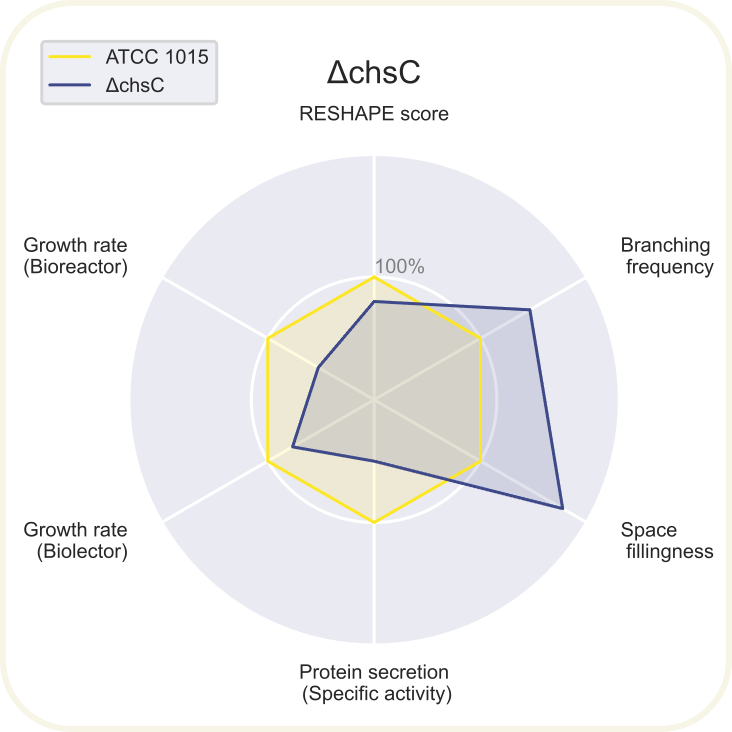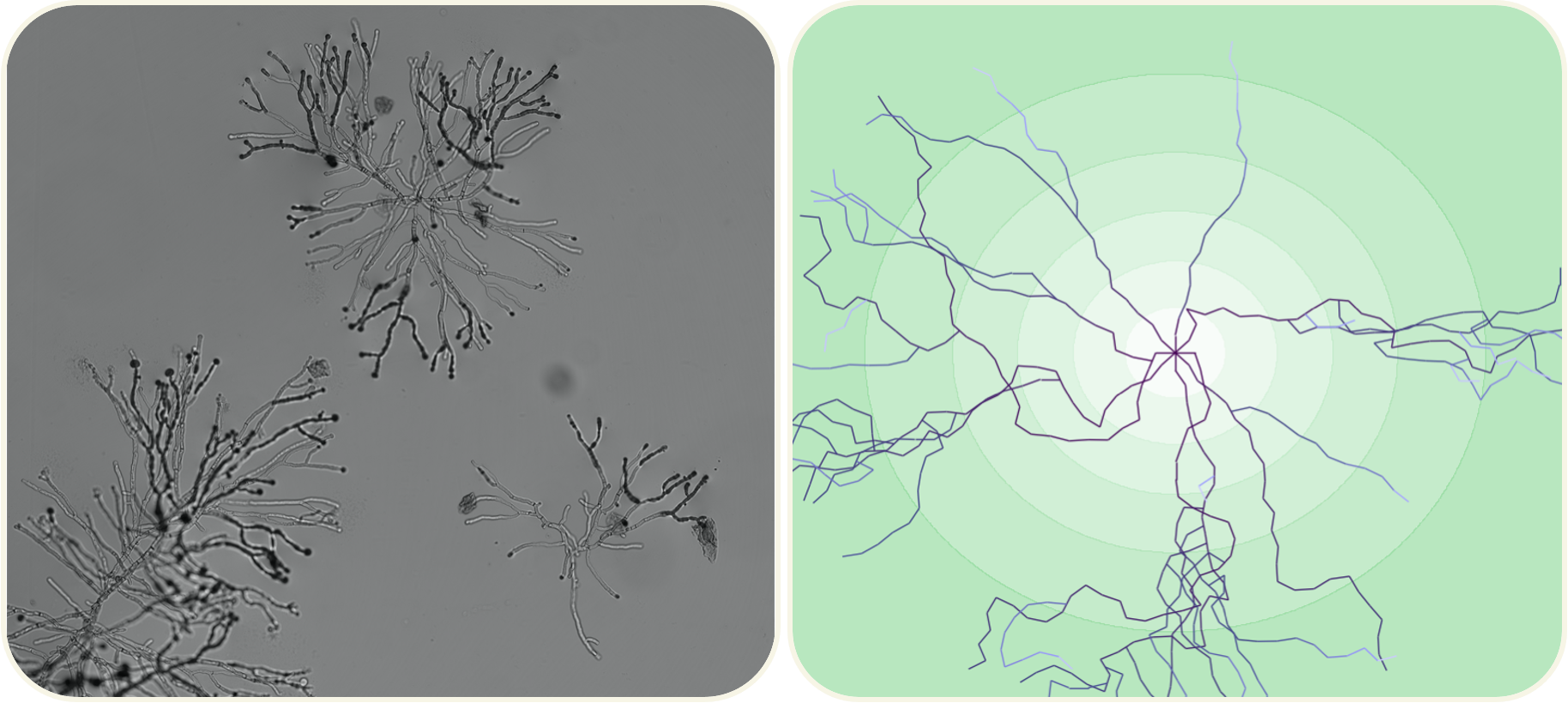Part:BBa_K3385014
CRISPR_chsC_KO
Theoretical expectation: chsC encodes a chitin synthase. It is involved in hyphal wall integrity and in conidiophore development. Deletion of the gene was expected to give more dense pelleted growth and an increased citric acid production.
Full guide construct for knockout of the Putitative Chitin synthase gene (chsC) in A. niger. This BioBlock has to be cloned into the PacI/Nt.BbvCI digested pFC330 backbone.

Functionality: The sgRNA efficiency has been accessed through the technique to assess protospacer efficiency (TAPE) [2]. A repair oligo is used to mediate homologous recombination, where a highly efficient sgRNA will show no colonies without the repair oligo, while less efficient sgRNA will show a reduced number of colonies.
Results: Below is a picture showing A. niger transformed with CRISPR_chsC_KO and the repair oligo for chsC. It shows efficient gene deletion when it's transformed with a repair oligo.

To see if the K/O’s were successful, other than looking at macromorphology, tissue PCRs were performed. By the amplification of specific primers, upstream and downstream of the gene, it can be verified if the gene has successfully been knocked out. If it has been knocked out the primers are gonna be closer to each other resulting in a smaller band in the Tissue PCR. However, if the gene is still present in the genome, the band size will be the same as the target gene as seen in the table below.
| Targeted gene | Expected gene length after K/O | Control lenght |
|---|---|---|
| ΔchsC | 704 bp | 1867 bp |
| ΔpkaR | 370 bp | 1661 bp |


Radar chart showing 6 different parameters of ΔchsC normalized to the reference values from ATCC 1015 (shown in yellow). Read about the axis in the summary section on the result page.
Plates
The strain was grown on Yeast Extract Peptone Dextrose (YPD), Transformation Media (TM), Creatine Sucrose Agar (CREA) and Czepek Yeast Extract Agar (CYA).
Microscope pictures and Simulation model

Left: Confocal microscope picture of ΔchsC at 10X magnification after app. 24h growth. Right: Growth simulation for 12h performed using the Mycemulator.
Microscopic images were analyzed by the image analysis tool extracting growth parameters which were then fed to the Mycemulator. A simulation of ΔchsC growing for 12 hours (using experimental growth rate from our BioLector data) is seen above.
Parameters specific for simulating ΔchsC:
- Branching frequency: 0.0251938
- Gamma distribution parameters used for curvature angles: (1.5962901, 4.3710747)
- Beta distribution parameters used for branching angles: (2.294856826, 0.9438161)
- Experimental growth rate: 0.21145
BioLector
Comparing the growth kinetics of the ΔchsC mutant with the reference strain ATCC 1015 in the BioLector, the mutant exhibits a longer lag phase followed by an equivalently long exponential growth phase. The growth rate for the mutant is slightly lower than for the reference strain, at μMax0.21h-1 versus μMax0.28h-1.
Growth profile of ΔchsC over 72 hours, measuring absorbance at 620 nm. Plotted against the reference strain (ATCC 1015) shown in yellow.
Bioreactor
Looking at the growth of the ΔchsC mutant in the bioreactors, it showed a shorter lag phase followed by a longer exponential growth phase when comparing it with the reference strain ATCC 1015. The growth rate is lower than the reference strain, at μMax0.23h-1 and μMax0.22h-1 versus μMax0.42h-1 for both reference duplicates. The fermentation was accidentally run with overpressure and is therefore only directly comparable with the ΔspaA mutant strain and with one run of the ATCC 1015 fermentations, due to these bioreactors also being run with overpressure. Glucose consumption starts slowly but increases quickly after the mutant stops growing.
Growth curve obtained from the off-gas analysis (CO2-44 (%)) of ΔchsC plotted against the reference strain (ATCC 1015) in a logarithmic scale. Right axis: Glucose consumption by ΔchsC during the fermentation in g/L (dark green).

Light microscope picture of ΔchsC after 22 hours of fermentation with a 20X magnification.
Microscope pictures of the bioreactor sample for ΔchsC had a very different morphology from the brightfield microscopy pictures seen above. It showed an increase in agglomeration along with a more hyperbranched phenotype.
Protein secretion
As seen in the figure below glucoamylase activity increases over time during the fermentation. The mutant exhibits lower glucoamylase activity compared to the reference strain.
Glucoamylase activity in UA/mL of ΔchsC from eight samples taken during the fermentation. Plotted against the reference strain (ATCC 1015) shown in yellow.
The final protein concentration is also significantly lower for the mutant strain than for reference strain, which is consistent with the reduced glucoamylase activity level. This is shown in the bar chart below.

ΔchsC bioreactor duplicates compared to reference strain (ATCC 1015) of the last time-point samples from the fermentations. Green: Glucoamylase activity in UA/mL. Blue: Specific activity in UA/mg calculated from the activity and the protein concentration. Purple: Protein concentration in mg/mL.
Sequence and Features
- 10INCOMPATIBLE WITH RFC[10]Illegal EcoRI site found at 489
Illegal EcoRI site found at 660
Illegal EcoRI site found at 831
Illegal SpeI site found at 978 - 12INCOMPATIBLE WITH RFC[12]Illegal EcoRI site found at 489
Illegal EcoRI site found at 660
Illegal EcoRI site found at 831
Illegal NheI site found at 333
Illegal SpeI site found at 978 - 21INCOMPATIBLE WITH RFC[21]Illegal EcoRI site found at 489
Illegal EcoRI site found at 660
Illegal EcoRI site found at 831 - 23INCOMPATIBLE WITH RFC[23]Illegal EcoRI site found at 489
Illegal EcoRI site found at 660
Illegal EcoRI site found at 831
Illegal SpeI site found at 978 - 25INCOMPATIBLE WITH RFC[25]Illegal EcoRI site found at 489
Illegal EcoRI site found at 660
Illegal EcoRI site found at 831
Illegal SpeI site found at 978
Illegal AgeI site found at 204 - 1000INCOMPATIBLE WITH RFC[1000]Illegal BsaI.rc site found at 162
References:
[1] A CRISPR-Cas9 System for Genetic Engineering of Filamentous Fungi. Nodvig CS, Nielsen JB, Kogle ME, Mortensen UH. PLoS One. 2015 Jul 15;10(7):e0133085. doi: 10.1371/journal.pone.0133085. eCollection 2015. PONE-D-15-11561 [pii] PubMed 26177455
[2] Efficient Oligo nucleotide mediated CRISPR-Cas9 Gene Editing in Aspergilli. Nodvig CS, Hoof JB, Kogle ME, Jarczynska ZD, Lehmbeck J, Klitgaard DK, Mortensen UH. Fungal Genet Biol. 2018 Jan 8. pii: S1087-1845(18)30004-5. doi: 10.1016/j.fgb.2018.01.004. 10.1016/j.fgb.2018.01.004 PubMed 29325827
